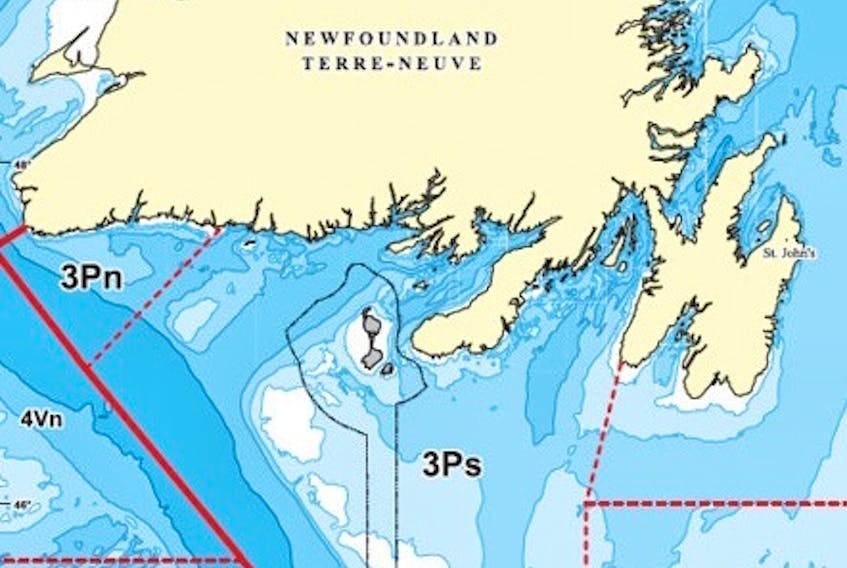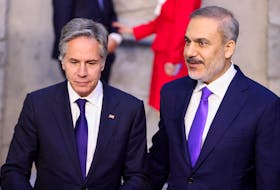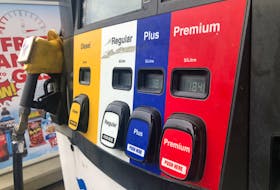MARYSTOWN, N.L. — Ross Durnford of Fortune has seven deep freezers powered up to keep 1,000 pounds of bait frozen until next cod fishing season, after the Department of Fisheries and Oceans (DFO) shut down the cod fishery in his fishing zone.
Durnford had 10 tubs of cod fishing gear baited up and ready to drop in the water, but the early closure of the fishery in zone 3Ps — on the south coast of Newfoundland — forced him to cancel his plans.
Durnford and other inshore fishers who catch cod in the area learned of an early shutdown to the fishery on Jan. 11. The Department of Fisheries and Oceans (DFO) gave them just one day, until 6 p.m. on Jan. 12, to have their cod fishing gear out of the water.
The inshore portion of the total allowable catch (TAC) for the 2018-19 fishery had been caught. The season normally ends on Feb. 28.
Many harvesters say DFO should have given them more advance notice of the early closure.
Durnford said 3Ps harvesters should probably have been expecting the closure because they knew the cod quota was cut.
DFO’s latest assessment of cod in 3Ps last fall indicated the stock remains in the cautious zone. The TAC was cut in half for the 2017-18 season, from 13,000 metric tonnes to 6,500 metric tonnes. It was further reduced to 5,980 metric tonnes for 2018-19.
Fishers can also contact DFO to check the percentage that has been caught at any time, Durnford noted, but just didn’t think to do so.
Even though he admits to being partially to blame, Durnford said he was initially pretty upset by the sudden closure.
“I suppose they could have put a release out, (saying) it’s a new TAC this year, it’s one-third of what it used to be and beware, it’s soon going to be caught,” he said.
“A heads up would have been excellent.”
Some fishers wait
Garnish harvester Alfred Fitzpatrick says the quota cut for this season, combined with the fact the cod came to shore earlier than expected, were factors that led to the early closure.

Fitzpatrick, who also represents harvesters from the Burin Peninsula on the Fish, Food and Allied Workers (FFAW-Unifor) union’s inshore council, says it’s likely most fishers in 3Ps did catch their quota, but there are some in the bottom of both bays who usually wait.
“They got hurt,” he said.
Fitzpatrick says DFO should have given more notice of the impending closure, adding harvesters shouldn’t have needed to call to find out how much of the quota was left.
According to Fitzpatrick, DFO indicated harvesters who bought quotas and didn’t have an opportunity to catch the fish would not be reimbursed as there was no way to do so.
Fitzpatrick said DFO should at least have had something in place to give fishers back their individual quota (IQ) fees.
“I mean, they paid for something basically they haven’t got a chance to catch,” he said.
‘Embarrassing’
Southern Harbour fisherman Peter Leonard didn’t hold back his thoughts on the early closure.
He said it was “disgraceful” that DFO would shut down the 3Ps cod fishery to the inshore so close to the end of the season and with so few fishermen left without catching their IQs.
“The amount of fish that it would take for these people to get their IQs, it’s embarrassing for government,” he said.
“It belittled the government and was so unfair to the harvesters. It was almost like a sneak attack – no warning.”
Leonard also expressed concern about the cod stock science for 3Ps, saying he believes it doesn’t match up with what harvesters are reporting.

DFO will announce the 3Ps cod quota for 2019-20 in the coming months. Leonard doesn’t believe the quota should be rolled over. If all licence holders in 3Ps fished their IQ with no bumps, 5,980 metric tonnes would not be enough for everyone unless IQs are cut, he says.
“My suggestion is instead of a rollover from last year, we should have an increase to 8,500 tonnes. Fish harvesters feel that we can withstand more than that, but we would be satisfied with 8,500 tonnes,” Leonard said.
Dragger concern
Fitzpatrick says permission from DFO for offshore vessels to catch cod in 3Ps late in the season, when the fish are gathering up to spawn, continues to irk many inshore harvesters.
The larger offshore draggers have 14 per cent of the Canadian TAC.
“It’s not the point of ’em getting a share. Like nobody cares about ’em having fish to catch,” Fitzpatrick says, acknowledging the employment the offshore catch creates on vessels and in plants.
“It’s when they’re catching it and where they’re catching it. It’s the time of year,” he says.
Fitzpatrick says it’s common knowledge cod fish congregate in the gullies in southern 3Ps prior to spawning, which usually occurs from April to June.
“If you comes through and tows a net through the bit of fish that’s there, it’s not only the fish you’re catching, you’re driving the fish away from the area. You’re disrupting the spawning pattern we’ll call it, right?” Fitzpatrick said.
If the offshore vessels were catching fish in October or November, there wouldn’t be an issue, he says.
The offshore vessels gave up fishing cod in 3Ps without taking the full quota allotted to them last year because it wasn’t economically viable, Fitzpatrick suggested.
“There wasn’t enough there,” he said
Fitzpatrick, who says the inshore fishery has implemented closed areas in 3Ps for when cod are gathering to spawn, also claims the FFAW backed the offshore vessels in the past.
“They might deny it, but they did. We were all at the meeting. So you can’t only blame DFO,” he said.
“Nobody is putting the stock first and there’s a lot of people depends on that stock of fish.”
Market consideration
According to a release from the Atlantic Groundfish Council (AGC), which represents year-round groundfish harvesters in Atlantic Canada, the offshore vessels wait until winter to fish in 3Ps because the quality of the cod is at its highest and supply from the inshore is also limited.
The timing enables the industry to meet the demands of premium markets in Europe, the release adds.
“DFO’s decision is consistent with the principals of sustainable fisheries resource management in Canada and meets the expectations of global markets keenly focused on buying only responsibly harvested seafood,” AGC executive director Kris Vascotto said in the release.
Wrapping up the offshore fishing season by the end of February ensures harvesting doesn’t occur during the spawning season, the release also states.
The FFAW issued a release upon the closure’s announcement calling for offshore draggers to be removed from 3Ps.
“Allowing the offshore to continue fishing with a quota below 10,000 tons would only intensify the economic crisis inshore harvesters are facing in this area,” FFAW-Unifor president Keith Sullivan stated.
False claims
The AGC suggests FFAW-Unifor and the Federation of Independent Sea Harvesters of Newfoundland and Labrador (FISH-NL) have both distorted a decision by the offshore fleet in the 3Ps cod fishery in 1997 to voluntarily not catch its quota.
That was the first year the 3Ps cod fishery was open after the 1993 moratorium; according to background information released by the AGC, the decision was made because the offshore sector felt the proposed level of fishery would hurt the stock.
The AGC contends this has resulted in a misleading claim that the offshore vessels are to be excluded from the 3Ps cod fishery when the quota falls below 10,000 metric tonnes.
“It’s concerning to see the year-round sector’s decision, putting the sustainability of the stock first and foremost, is being used against the sector by special interest groups,” the AGC information states.
“The FFAW, and now FISH-NL, have twisted this 1997 offshore sector voluntary decision as a mandatory exclusion based on an imaginary number of 10,000mt when industry groups know that was never the case.”
DFO response
The Department of Fisheries and Oceans responded via email to questions posed by The Southern Gazette about the early closure of the 3Ps inshore cod fishery as well as offshore vessels fishing in the pre-spawning period.
On the closure, DFO said it endeavours to provide advance notice to harvesters on all fishery closures.
DFO said out the 3Ps cod fishery is managed under an overall TAC within which fleet allocations are distributed.
“DFO monitors landings to ensure a fleet’s catch does not exceed its allocation, however, when a fleet is projected to reach its allocation the fishery is closed. The amount of notice given can vary depending on the rate of harvest, including the level of activity,” the email stated.
“Sometimes these allocations are reached quickly and DFO balances providing adequate notice to harvesters while ensuring the TAC isn’t exceeded, to maintain conservation and sustainable harvesting principles.
“The timing of the 3Ps cod closures was discussed with harvesters at the 3Ps Groundfish Advisory on Thursday, Jan. 10 and an announcement was made regarding the closure the following day.”
As for allowing draggers to fish in 3Ps during the pre-spawning stage, DFO acknowledged the current spawning closure period is March 1 to May 14.
“While little is known about whether fishing prior to spawning (i.e. pre-spawning) has any lasting impacts on spawning-related behaviours and spawning success, recent sampling from the offshore area suggests that this closure protects an extended portion of the pre-spawning period, with spawning likely beginning sometime in April,” the email stated.
2018-19 3Ps cod allocations (tonnes)
Total allowable catch (TAC) – 5,980
French quota – 933
Sentinel fishery – 80
Aboriginal quota – 13
Vessels under 100 feet – 4,222
Vessels above 100 feet – 732
Source: Department of Fisheries and Oceans









